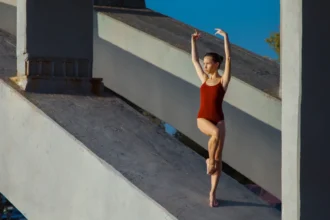When it comes to gymnastics, size really does make a difference. Female gymnasts are known for being shorter than most athletes, and that compact build gives them an edge in power, balance, and speed. But just how tall are they on average, and why does their height matter so much in the sport?
Average Height Range of Female Gymnasts
Most elite female gymnasts fall between 4’9” and 5’3” (145–160 cm). This is notably shorter than the average adult woman in most countries, making compact stature a defining trait of the sport.
- Shorter gymnasts (around 4’9”–5’0”) often excel in fast-twisting skills, such as double layouts or twisting vaults, where rapid rotation is crucial.
- Taller gymnasts (closer to 5’3”–5’4”) sometimes shine on uneven bars, where longer lines allow for more elegant extension and fluid swing mechanics.
Although the average hovers near 5’0”, the range is broader than many expect. Olympic data shows that over 25% of female gymnasts are 5’3” or taller, placing them close to or even above the U.S. female average.
On Reddit, fans suggest the spectrum extends from as short as 4’1” (125 cm) to as tall as 5’9” (175 cm), though most cluster around the 5’0” mark.
Individual Examples
- Simone Biles (USA) – 4’8” (142 cm), one of the shortest yet most powerful gymnasts in history.
- Marie-Sophie Hindermann (GER) – 5’7” (170 cm), among the tallest gymnasts ever to compete at the Olympic level.
This wide range shows that while a smaller stature offers advantages, success is not confined to one body type.
Historical Trends
The average height of female gymnasts hasn’t always been so low. Over the decades, the sport has steadily shifted toward favoring smaller athletes.
- Early Olympic era (pre-1970s): Gymnasts averaged about 5’3” (160 cm), with routines focused more on elegance and dance-like expression than on high-difficulty acrobatics.
- 1970s (e.g., 1976 Olympics): The average fell to about 5’0” (152 cm). The rise of Nadia Comăneci and the increasing emphasis on acrobatics marked a turning point.
- Long-term decline in the U.S.: From the 1950s to the 1980s, the average height dropped from 161.8 cm (5’3.5”) to 149.1 cm (4’10.5”). By 2008, it rebounded slightly to around 153 cm (5’0”).
These changes mirror the evolution of scoring systems, rising skill difficulty, and global competition, all of which began to favor compact, explosive athletes.
Source: (Topend Sports, PMC)
How Height Varies by Country in Women’s Gymnastics
While gymnasts are generally shorter than average women, height trends differ across countries and training systems.
United States
- Typical range: 4’8”–5’2” (142–157 cm)
- Focus: Power and difficulty, especially on vault and floor
- Notable examples: Simone Biles (4’8”), Sunisa Lee (5’0”)
Romania
- Typical range: 5’1”–5’4” (155–163 cm)
- Focus: Elegance and clean execution
- Notable example: Nadia Comăneci (5’4”), taller than many gymnasts competing today
Russia
- Typical range: 5’3”–5’5” (160–165 cm)
- Focus: Artistry and long lines, particularly on uneven bars
- Notable example: Svetlana Khorkina (5’5”), who turned her height into an advantage with innovative bar skills
China
- Typical range: 4’7”–5’0” (140–152 cm)
- Focus: Precision, flexibility, and beam excellence
- Notable examples: Deng Linlin (4’8”), He Kexin (4’9”)
Western Europe (Great Britain, Germany, etc.)
- Typical range: 5’0”–5’4” (152–163 cm)
- Focus: Blending power with artistry
- Notable example: Beth Tweddle (5’3”), Britain’s most decorated gymnast
| Country/Region | Average Height Range | Notable Example | Notes |
|---|---|---|---|
| United States | 4’8”–5’2” (142–157 cm) | Simone Biles (4’8”) | Emphasis on power and difficulty |
| Romania | 5’1”–5’4” (155–163 cm) | Nadia Comăneci (5’4”) | Focus on clean execution and elegance |
| Russia | 5’3”–5’5” (160–165 cm) | Svetlana Khorkina (5’5”) | Taller gymnasts excel on bars |
| China | 4’7”–5’0” (140–152 cm) | He Kexin (4’9”) | Compact builds dominate beam and bars |
| Western Europe | 5’0”–5’4” (152–163 cm) | Beth Tweddle (5’3”) | Balanced focus on artistry and power |
Why Are Female Gymnasts Often Shorter Than Average?
Several factors combine to make shorter stature the norm in women’s artistic gymnastics.
1. Biomechanical Advantages
- Strength-to-weight ratio: Smaller athletes generate more power per pound, crucial for vault and tumbling.
- Rotation speed: A compact build means quicker spins and twists in the air.
- Balance: Lower center of gravity helps on narrow apparatuses like beam.
2. Selection Bias
Shorter athletes tend to progress more quickly in gymnastics. Coaches notice and encourage them to specialize, creating a cycle where smaller gymnasts are more likely to reach elite levels and set the standard.
3. Impact of Intensive Training
Research suggests that high-intensity training in adolescence may delay growth and puberty but rarely causes permanent stunting. Growth “catch-up” usually happens once training intensity eases. Genetics remains the dominant factor in final height.
4. Age and Maturation
Many elite female gymnasts peak in their mid-teens, often before or during puberty. Naturally, they appear shorter compared to adult athletes in other sports. Growth spurts during later adolescence sometimes shift body proportions, which can affect performance and lead to earlier retirements.
Comparisons to Other Gymnastics Disciplines
Not all disciplines favor shorter athletes:
- Rhythmic gymnastics: Athletes are typically taller and more slender (5’5”–5’8” / 165–173 cm) to highlight long lines and extensions.
- Trampoline gymnastics: Heights vary more widely, usually sitting between artistic and rhythmic averages.
Different disciplines reward different builds, showing the diversity of body types within gymnastics.
Does Height Limit Success?
Not at all. While the majority of female gymnasts fall into a shorter range, history proves that outliers can still dominate. Svetlana Khorkina (Russia), at 5’5” (165 cm), became one of the most decorated gymnasts of all time, leveraging her taller frame to redefine uneven bars.
Bottom Line
The average height of female artistic gymnasts is around 4’9” to 5’3” (145–160 cm). Compact builds naturally support balance, rotation, and control, explaining why shorter gymnasts often excel.
Still, height alone doesn’t decide success. Champions prove that skill, creativity, and determination matter far more than inches on a measuring tape.






